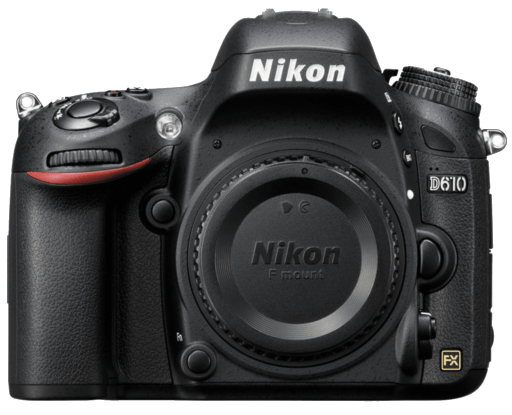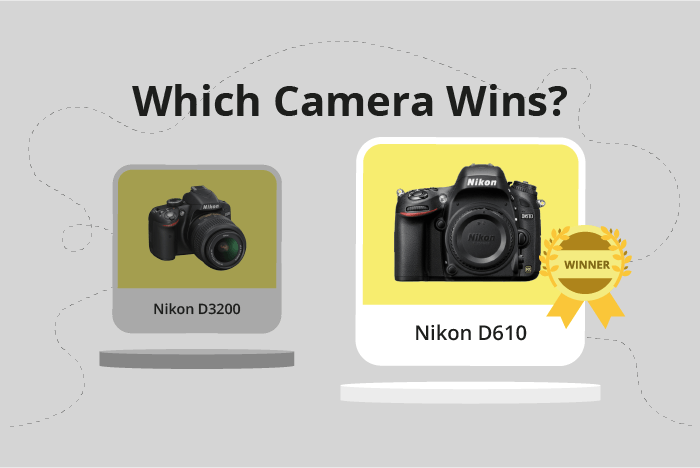Nikon D3200 vs D610 Comparison
Nikon D3200

Nikon D610

The Nikon D610 emerges as the winner with a score of 66/100, while the Nikon D3200 scored 54/100. Both cameras share similarities, being DSLRs released in 2012 and 2013, with sizes of 125 x 96 x 77mm for the D3200 and 141 x 113 x 82mm for the D610. The D610 outperforms the D3200 with its higher launch price of $1,999 compared to $699, but it is also heavier at 850g compared to the D3200’s 505g.
The D610’s higher score reflects its overall superior performance, while the D3200 may be more suitable for those seeking a lighter, budget-friendly option. Each camera has its own strengths and weaknesses, making them suitable for different needs and preferences.
Nikon D3200 vs D610 Overview and Optics
The Nikon D610 outperforms the Nikon D3200 in terms of optics, scoring 70/100 compared to the D3200’s 63/100. Both cameras share some common specifications, such as a CMOS sensor type, Expeed 3 processor, and the absence of image stabilization. However, there are notable differences between the two models that contribute to the D610’s higher score.
The D610 boasts a full-frame sensor, while the D3200 has an APS-C sensor. The full-frame sensor in the D610 is superior, as it provides better image quality, particularly in low light conditions. Furthermore, the D610 has a higher DXOMARK score of 94 for its sensor, compared to the D3200’s 81. This demonstrates the D610’s superior sensor performance. Additionally, the D610 has a faster shooting speed of 6 frames per second (fps), compared to the D3200’s 4 fps, allowing for better capture of fast-moving subjects.
The D3200, however, has a slightly higher megapixel count at 24.2 MP, compared to the D610’s 24 MP. This difference is minimal and does not significantly impact the overall image quality. Both cameras also utilize the Nikon F lens mount, with the D3200 using the DX version and the D610 using the FX version. This means that both cameras are compatible with a wide range of Nikon lenses, offering versatility for photographers.
Taking into consideration the differences in sensor size, DXOMARK scores, and shooting speed, the Nikon D610 is the superior camera in terms of optics. While the Nikon D3200 has a marginally higher megapixel count, it does not compensate for the advantages the D610 offers. As a result, the Nikon D610 is the better choice for photographers seeking superior optical performance.
Nikon D3200 vs D610 Video Performance
The Nikon D610 outperforms the Nikon D3200 in video capabilities, scoring 57/100 compared to the D3200’s 43/100. Both cameras share some common specifications in this aspect: they both have a maximum video resolution of Full HD and maximum video dimensions of 1920 x 1080. Additionally, they both support a maximum video frame rate of 30fps.
The D610’s superior video score is due to its built-in time-lapse functionality, which the D3200 lacks. This feature allows the D610 to capture a series of images over a period and combine them into a single video, displaying the passage of time in a visually appealing manner. This added capability makes the D610 more versatile and appealing for those interested in time-lapse photography or videography.
On the other hand, the D3200 does not offer any specific advantages over the D610 in terms of video capabilities. Its lower score reflects the absence of the time-lapse functionality found in the D610. Therefore, for users who prioritize video performance, the D610 is the clear choice between these two cameras.
Based on the comparison of video specifications and capabilities, the Nikon D610 is the better option for those seeking superior video performance. Its built-in time-lapse functionality sets it apart from the Nikon D3200, which lacks this feature. While both cameras share other common video specs, the D610’s additional feature makes it the preferred choice for users who value video capabilities.
Nikon D3200 vs D610 Features and Benefits
The Nikon D610 outperforms the Nikon D3200 in features with a score of 57/100 compared to 41/100. Both cameras share common specifications, such as a 3-inch screen size, 921,000-dot screen resolution, lack of a touchscreen, flip screen, GPS, and Bluetooth. However, the D610 surpasses the D3200 in certain areas.
The D610’s advantage lies in its Wi-Fi capability, allowing for easier sharing and transfer of photos. This feature is absent in the D3200, which may limit its appeal for those who prioritize connectivity. The D610 also has a slightly larger screen size of 3.2 inches, providing a marginally better viewing experience for users.
On the other hand, the D3200 may still appeal to some users despite its lower feature score. Its lower score does not necessarily imply inferiority in all aspects, and it might suit the needs of certain photographers. For instance, beginners may find the D3200 more accessible due to its lower price point and simpler feature set. Additionally, the lack of Wi-Fi and other advanced features might not be a deal-breaker for those who prioritize other aspects of a camera, such as image quality or ease of use.
When considering the Nikon D3200 and D610, one must weigh their individual preferences and needs. The D610 offers better connectivity and a slightly larger screen, making it a more appealing option for those who value these features. However, the D3200’s lower feature score does not necessarily mean it is a lesser camera, as it may better suit the needs of beginners or those with different priorities. Ultimately, the choice between these two cameras depends on the specific requirements of the user.
Nikon D3200 vs D610 Storage and Battery
The Nikon D610 outperforms the Nikon D3200 in terms of storage and battery, scoring 71/100 compared to the D3200’s 27/100. Both cameras accept SD, SDHC, and SDXC memory cards, but the D610 has an advantage with two memory card slots, while the D3200 has only one. Additionally, both cameras lack USB charging capabilities.
The D610 offers a significantly longer battery life, providing 900 shots per charge compared to the D3200’s 540 shots. This is due to the D610’s EN-EL15 battery, which is more powerful than the D3200’s EN-EL14 battery.
While the D3200 has fewer advantages in this category, it does have UHS-I compatibility, allowing for faster data transfer rates with compatible memory cards.
Considering these factors, the Nikon D610 is the superior camera in terms of storage and battery life, making it a better choice for those who require longer shooting sessions and greater storage flexibility. The Nikon D3200, though, benefits from UHS-I compatibility, which may be an important feature for some users.
Nikon D3200 vs D610 – Our Verdict
Are you still undecided about which camera is right for you? Have a look at these popular comparisons that feature the Nikon D3200 or the Nikon D610:

